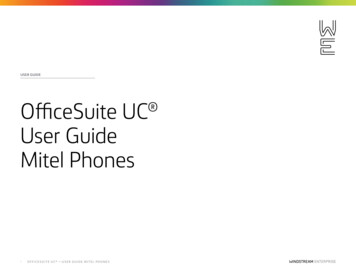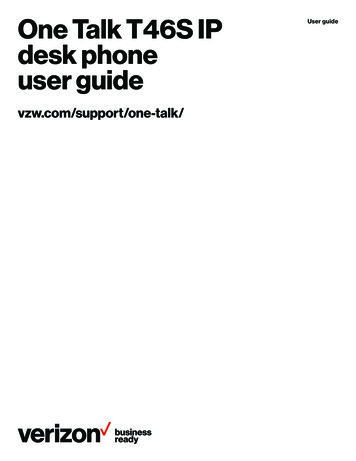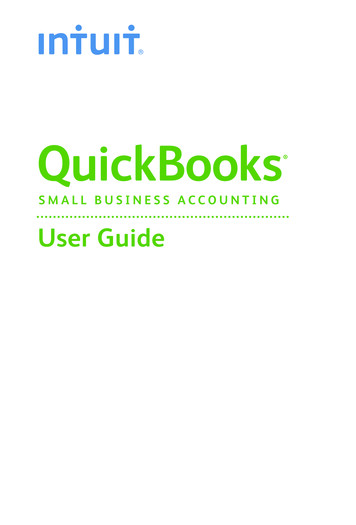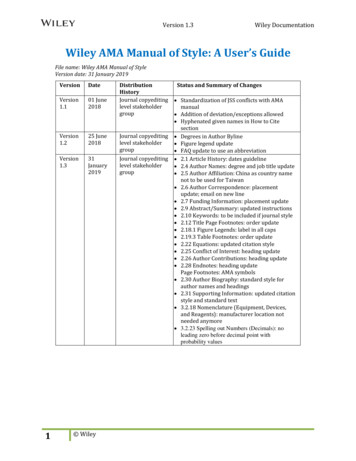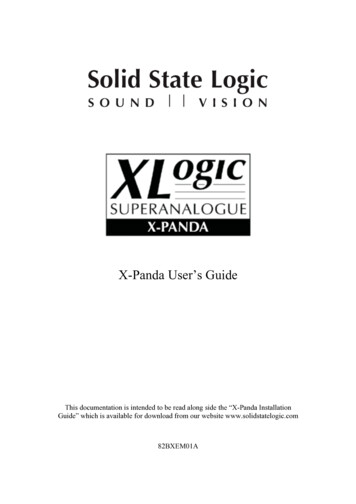
Transcription
X-Panda User’s GuideThis documentation is intended to be read along side the “X-Panda InstallationGuide” which is available for download from our website www.solidstatelogic.com82BXEM01A
ContentsIntroduction to the X-PandaX-Panda Operator’s GuideMono Inputs – Input (CH IP), Alternate Input (ALT)Outputs - Direct Channel Outs (CH OP), Post FaderStereo Cue – Post Fader, ALT sourceFX Sends and Stereo Returns (ST RET)Channel Pan, Fader, Cut & SoloStereo Inputs – Input (CH IP)Power up OptionsAdditional InformationRear DIP SwitchesCascading X-Panda and X-DeskX-Panda and the X-RackX-Panda and other audio equipmentRacking your X-Panda
INTRODUCTIONExpand your studio with an SSL!Solid State Logic are delighted to introduce its latest analogue offering, the X-Panda,built with the very same SuperAnalogue DNA as our AWS, Duality and Matrixconsoles. SSL sincerely hope that you enjoy this compact analogue product.X-Panda is a 24 Input mixer that can be used for tracking and master mix summing.The purpose of the X-Panda is to augment any existing system. Obviously a naturalpartner would be SSL’s own award winning X-Desk. However, X-Panda is designedto work with any analogue audio equipment, the limit is really your own imagination.Remember this is a true expander in the convenient analogue domain.X-Panda was primarily born out of requirements from existing X-Desk owners foradditional inputs for a larger analogue studio system. When used in conjunction withan X-Desk it creates a 44 input SSL studio mixing system.Initially the X-Panda may appear to be a relatively basic analogue console, howeverthere are a number of design innovations that could significantly enhance yourstudio’s sonic output. If you take a short time to read this guide through, hopefullyyou will discover a few novelties, which may enhance your recording and mixingsessions.You may wish to consider exactly how you will integrate X-Panda into your studioalong with your existing equipment. Taking time to plan X-Panda’s integration canyield sonic benefits later on.Some example system setups are included in the X-Panda Installation guide includedin your package.X-Panda can be used as an elegant and ergonomically refined desktop mixer or placedin a 19” rack (by virtue of the supplied removable rack ears) in a 7U space.Like all SSL SuperAnalogue products, it is extremely robust, hand-built in the UKwith an all-metal chassis and utilises high quality controls and components.X-Panda combines a 24 input SSL SuperAnalogue mixer with the ability to truly“expand” the other equipment in your studio.
The X-Panda Mono Channel StripInputs – Channel Input (CH IP), Alternate Input (ALT)Each one of the 8 mono channel inputs (CH IP) on the XPanda has a choice of two Line Inputs. The first input istraditionally sourced from the Output of a microphone preamplifier, D.I box or perhaps even a line level instrument.These connections are labelled “LINE IN 9-16 (1-8)” on therear of the desk. They are so labelled due to the fact that youmay be using X-Panda stand alone or in conjunction with an XDesk or indeed additional audio equipment.The second Line input is selected via the switch labelled “ALT” and is mostcommonly used for Monitor return playback signals, perhaps from a Digital AudioWorkstation (DAW). These connections are labelled “ALT IN 9-16 (1-8)” on the rearof the desk.Once you have selected your Input, it then has a /- 20 dB gain Level Trim, indentedin the centre at Unity Gain and a Phase Reverse “Ø” button.The Post gain signal can also then be affected by Insert processing (perhaps an EQ orDynamics processor.) by pressing the “INS” switch. It is worth noting that in SSLtradition the Insert Send is always active, which can be creatively utilised if you sowish. Engaging the “INS” switch will activate the Insert return. (All Mono ChannelInserts are connected via the “INSERT SEND/RETURN 9-16 (1-8)” connections onthe rear of the desk)The Tri-colour Led under the level control is a 3 colour indictor of signal presenceand level. By default the following audio levels are indicted by the following LEDstates:Green Yellow Red -24 dBu 4 dBu 21 dBuRemember it is possible to rescale the X-Panda’s metering to a 18dBu (as opposedto the standard 24 dBu) scale via the rear panel DIP switch. This would thenprovide the following channel meter scale.Green Yellow Red -24 dBu0 dBu 16 dBuNote: The Red LED will light before actual audio clipping, which can serve as auseful warning when recording.2
Outputs - Direct Channel Outs (CH OP), Post FaderEach Mono channel of the X-Panda has a Direct Output. TheChannel Direct Outputs (CH OP) are primarily used to feed theinputs of your chosen recorder or DAW. On the rear panel connection panel of XPanda they are labelled “CHAN OUT 9-16 (1-8)”.The operator has a choice of whether the output Signal is sourced Pre or Post fader.By default the output is Pre fader / Post Input Trim but by selecting “POST” theOutput level will be sourced after, and thus controlled by, the Channel Fader. This isuseful if in classic British audio engineering style one wishes to “ride” the signal levelto tape or in this modern day and age, the DAW.Stereo Cue – Post Fader, ALT sourceThis is the channel send to the Stereo CUE Bus. There areseparate controls for both Level and Pan, and this is normallyused as a Cue audio feed for the recording artist. But this is justthe beginning!Selecting the POST switch will source the Stereo Cue post thechannel fader.A very useful feature of the X-Panda mono channels is that the CUE ST can sourcethe ALT channel input (even if it has not been selected as the main channel input.) Toachieve this simply engage the “ALT” switch. This is useful when recording as anentirely independent Cue mix can be built up.Alternatively if the requirement is for a large analogue summing system (when usedin conjunction with an X-Desk), an additional 8 channels could be connected to theALT input, sourced on the CUE with independent Level and Pan, and reassigned tothe MIX bus via the CUE to MIX button on the Master section of an X-Desk.Note: Selecting ALT (on the CUE send) when it is sourced as the Channel Input willresult in no change to the Cue source.FX Sends 1&2 and Stereo Returns (ST RET)Each Mono Channel on the X-Panda has two mono FX sends(FX1 and FX2)The Send is permanently ON but rotating it fully counterclockwise will result in no signal being sent onto the FX bus.Normally the FX sends are sourced Post Fader but they can be globally switched forthe whole X-Panda by the PRE switches on the last Stereo Channel. (See nextsection)3
Channel Pan, Fader Cut & SoloAt the base of the X-Panda Mono channel strip you will findtraditional analogue desk functions.The channel stereo “PAN” control, which controls the channelsLeft/Right positioning on the Stereo Mix bus.The analogue signal level FADER, for feeding the Stereo Mix Busor controlling the CH OP (Direct Channel Output) level.Above the Fader you will find two switches:The “SOLO” button, which mutes all other channels and providesan AFL monitoring signal, and finally the “CUT” button whichimmediately mutes the channel’s output.4
THE X-PANDA STEREO CHANNEL STRIPThe X-Panda features 4 Stereo Input Channels that differ slightly from the MonoChannels.Stereo Inputs – Channel Input (CH IP)The X-Panda Stereo Input channels (CH IP) feature a /- 20 dB gain stereo LevelTrim, indented in the centre at Unity Gain and a pair of independent Phase Reverse“Ø” switch for both the L R Inputs.The Post input gain signal can also then be affected by Insert processing (perhapsstereo EQ or Dynamics processing) by pressing the “INS” switch. On the Stereochannels on the X-Panda the Insert point is true Stereo.It is worth noting that in SSL tradition the Insert Send is always active, which cancreatively utilised if you so wish. Engaging the “INS” switch will activate the Insertreturn. (All Stereo Channel Inserts are connected via the INSERT SEND/RETURNST 1-4 connections on the rear of the X-Panda)There are independent Level Meters for both Left and Right Signals of your Stereosource.The Tri-colour LEDs under the level control are 3 colour indictors of signal presenceand level. By default the following audio levels are indicted by the following LEDstates:Green Yellow Red -24 dBu 4 dBu 21 dBuRemember it is possible to rescale the X-Panda’s metering to a 18dBu (as opposedto the standard 24 dBu) scale via the rear panel DIP switch. This would then providethe following channel meter scale.Green Yellow Red -24 dBu0 dBu 16 dBuNote: The Red LED will light before actual audio clipping, which can serve as auseful warning when recording.5
Stereo Outputs - Direct Channel Outs (CH OP), Post FaderEach X-Panda Stereo channel features a dedicated Channel Output (CH OP). Thisprovides a direct Stereo Output.Normally this is sourced Pre Fader but by engaging the “POST” switch that sourcebecomes Post Fader. The Channel Direct Outputs (CH OP) are primarily used to feedthe inputs of your chosen recorder or DAW. On the rear panel connection panel of XPanda they are labelled “CHAN OUT ST 1-4”.(Note that there is no “ALT” option on the X-Panda Stereo Channels)Stereo Cue SendProvides a Stereo Send primarily for Cue purposes. By default the signal is sourcedpre fader but additionally it can be sourced after the Channel Fader by selecting“POST”. It may be worth bearing in mind that if you are using X-Panda inconjunction with an X-Desk and on the X-Desk are using the “Cue to MIX” functionyou may wish to turn this CUE ST send off on the X-Panda Stereo channels.FX Sends 1&2There are two FX sends on the Stereo channels and they take a summed Mono signalof your Stereo Input source. By default the signal is sourced post Fader.6
Note that it is possible to globally switch the FX Sends independently for the X-Pandato source the signal pre fader by engaging the “PRE” switch for either of the two FXSend busses on the last X-Panda Stereo Channel.Channel Balance, Fader, Cut & SoloAt the end of the Stereo Channel there is a Balance control. Notethat this is entirely different to the Pan control on the Monochannels. Simply, it controls the channels respective Left/RightLevel feed to the Stereo Mix Bus. If you are unfamiliar with thistype of control it may be worth playing some stereo material intothe channel and experimenting with the control to perhaps give youan idea of it creative potential.In addition to the usual Solo and Cut switches along with a longthrow Channel fader, all of which function as they do on the Monochannels.7
ADDITIONAL INFORMATIONRear DIP Switch OptionsThe rear of the X-Panda unit features a 4-way DIP switch which allows you to changethe Meter scaling of the signal LEDs on the channels.Switch number “1” alters the meter scaling between:0 dbfs 18 dBuor 0 dbfs 24 dbuNote: that the default factory setting is set to 24 dBuThe Diagnostics 1,2, and 3 switches are for internal SSL factory use only and shouldnot be engaged by the user without dire repercussions on a truly monumental scale.Well perhaps not that bad, but please don’t do it!Cascading X-Panda and X-DeskOne of the most useful features of the X-Panda/Desk is the ability for multiple units tobe cascaded together to build a bigger SSL system.It is possible to connect an X-Panda and X-Desk units together by simply connectingthe rear panel connection on the X-Panda “UNITE” to the “X-DESK LINK IN” onthe X-Desk. You should connect your monitor loudspeakers and FX processors to theX-Desk as it will be the main audio MIX bus, as well as acting as the master sends forthe CUE and FX busses.Currently we recommend that you connect no more than 8 X-Desk/Pandacombinations in a cascaded array.As mentioned, once connected the MIX, CUE, FX 1&2 and AFL solo Busses arecombined on the master X-Desk.So for example:If you engage SOLO on any channel, all other Channels in your cascaded XPanda/Desk System will mute.A single FX processing unit can be connected to the FX 1 or 2 output of the MasterDesk yet can be fed audio from sends on any of the cascaded desks.More advanced users may wish to consider the possibilities of such delights asparallel compression, differing FX destinations, extremely complex Cue sends and awhole host of other creative possibilities8
Using X-Panda with an X-Rack Summing SystemAlthough not essential, a natural partner for the X-Panda is an SSL X-Rack. Whilesome of the more obvious X-Rack modules such as the Mic Amp (XR621) or theVHD Input modules (XR627) would be suitable for recording various sources, and ofcourse the X-Rack EQ and Dynamics modules, Superanalogue (XR625) & (XR618)or 4000 series (XR425) & (XR418) would be a natural partner for audio processingduties.However the real fun begins if you would like to create a “bigger” analogue mixer.Because the X-Rack has a “Mix Bus Link”, if you have a Master Bus Module(XR622) simply connect the X-Panda’s “XRACK EXPANSION” to the X-Racks’“Mix Bus Link”Note: The X-Rack REC BUS (Record Bus) is fed from the X-Panda’s ST CUE as ithas no associated bus.Using X-Panda with other audio equipmentWhile you may assume that X-Panda is designed to only work in conjunction withother SSL equipment, you would be mistaken. X-Panda can be a welcome addition toany existing set up.Use with another audio mixing console:Lets assume you have a classic console from the good old days, or a highly affordableoffering from a current manufacturer. X-Panda allows you to add additional inputs forthis device. Simply connect from the Unite socket on the rear of the X-Panda to youraudio console. Remember that you can “break out” the 8-way D-sub (Using acommonly available D-Sub to 8x XLR cable for example) into its component audiosignal elements. So you can access the Stereo MIX bus, Cue bus the two Mono FXSends and of course, the AFL bus. You do not have to use all of these of course. SSLare providing you with a set of tools, and as ever you choose the correct one for thejob. A simple setup would involve simply connecting the X-Panda MIX bus to aStereo Input or indeed two mono channels. This would provide many more inputs intoyour console. A more complex set up might involve the above in combination withthe CUE and FX also connected. Useful if you wish to access hardware outboard FXequipment that is connected to the other mixing console. How you accomplish this onyour other console will either involve donating a channel for this purpose or somehave dedicated summing input often called Bus injects. Consult the documentationthat came with your other audio mixer to see what is possible and how it might workbest for you in your studio. No two mixers are alike!Use with another analogue summing system:The last few years has seen a growing appreciation for the benefits of analogue mixsumming. There are quite a few systems available and X-Panda can work inconjunction with any of them.9
Racking your X-PandaSupplied with the X-Panda are 2x Racking “ears”. These can be simply fitted to theDesk by the use of 3x screws per side (included) thus facilitating 19” rack mountingof the X-Panda. We recommend 4x screws for securing an ear equipped X-Panda intoa standard 19” rack.CONNECTIONSRear Panel Connections:LINE IN 9-16 (1-8)D-Sub 25 way femaleThe Primary Channel Input (CH IP) for the Mono ChannelsALT IN 9-16 (1-8)D-Sub 25 way femaleA secondary Mono Channel Input. Can be sourced as the main Channel Input (CHIP) or reassigned via the Cue Bus ALT function.INSERT SEND 9-16 (1-8)D-Sub 25 way femaleInsert Sends for the eight Mono Channels (Remember the Send is always active!)INSERT RETURN 9-16 (1-8)D-Sub 25 way femaleInsert Returns for the eight Mono ChannelsCHAN OUT 9-16 (1-8)D-Sub 25 way femaleDirect Channel Output (CH OP) from the eight Mono channels; selectable either Preor Post fader.LINE IN ST 1-4D-Sub 25 way femaleThe Stereo Channels Line Inputs (CH IP)10
INSERT SEND ST 1-4D-Sub 25 way femaleThe Stereo Channels Insert Send (Remember the Send is always active!)INSERT RETURN ST 1-4D-Sub 25 way femaleStereo Channels Insert ReturnCHAN OUT ST 1-4D-Sub 25 way femaleStereo Channels Direct Output (CH OP)UNITEAFL L RMIX L RCUE L RFX SEND 1FX SEND 2D-Sub 25 way femaleProvides AFL OutputMIX Bus OutputCUE Bus OutputFX 1 Bus OutputFX 2 Bus OutputX-RACK EXPANSIOND-Sub 25 way femaleThis connection allows X-Rack owners with a Master Bus module (XR622) to utilisethat for Master Bus functions and Monitoring control.It is also compatible with X-Racks loaded with any combination of the Four ChannelInput module (XR623) and Eight Channel Input module (XR624) in addition to theMaster Bus Module. This creates a large compact analogue summing system.Note: For all D-Sub Pin-outs please consult the Installation guide included with yourX-Panda11
Begbroke, Oxford, England OX5 1RU 44 (0)1865 842300320 West 46th Street, 2nd Floor, New York, NY 10036, USA 1 (1) 212 315 11113700 Wilshire Blvd,Suite 720, Los Angeles, CA 90036, USA 1 (1) 213 249 92293-55-14 Sendagaya, Shibuya-Ku, Tokyo 151-0051, Japan 81 (0)3 5474 11447 bis, rue de la Victoire, le Blanc Mesnil, Paris 93150, France 33 (0)1 48 67 84 85Via Timavo 34, 20124 Milano, Italy 39 (0)39 2328 094Visit SSL at http://www.solidstatelogic.com Solid State LogicAll Rights reserved under International and Pan-American Copyright ConventionsSolid State Logic, SSL, XLogic, Superanalogue and X-Deskare trademarks of Solid State LogicAll other trademarks are the property of their respective ownersNo part of this publication may be reproduced in any form orby any means, whether mechanical or electronic, without thewritten permission of Solid State Logic, Oxford, EnglandInitial release June 2011As research and development is a continual process, Solid State Logic reserves the rightto change the features and specifications described herein without notice or obligation.E&OE
Expand your studio with an SSL! Solid State Logic are delighted to introduce its latest analogue offering, the X-Panda, built with the very same SuperAnalogue DNA as our AWS, Duality and Matrix consoles. SSL sincerely hope that you enjoy this compact analogue product. X-Panda is a 24 Inp

